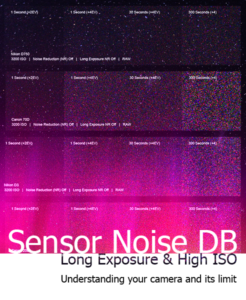 I shoot a lot of nightscapes and aurora’s. It’s not uncommon to see my camera in the 3200 to 6400 ISO range doing 30 second or longer exposures for extended periods of time. So for me one of the main performance criteria for any camera is long exposure noise. If your a keen photographer you would be aware that there a many sites offering reviews on new cameras, but few (none to my knowledge) test the sensor with a long exposure with no lens to get the base performance for sensor noise.
I shoot a lot of nightscapes and aurora’s. It’s not uncommon to see my camera in the 3200 to 6400 ISO range doing 30 second or longer exposures for extended periods of time. So for me one of the main performance criteria for any camera is long exposure noise. If your a keen photographer you would be aware that there a many sites offering reviews on new cameras, but few (none to my knowledge) test the sensor with a long exposure with no lens to get the base performance for sensor noise.
Most tests performed use a relatively short exposure (1 sec or shorter) at various ISO ratings, this is primarily done to show what is commonly known as sport performance. It’s assumed that the ISO to TIME relationship is linear i.e. a one second exposure at 3200ISO is the same as a 16 second exposure at 200 ISO. But the only real way to see how a camera is going to perform at 3200ISO for 5 mins is to test it.
A while back I started to tested sensors using this basic test:
Three exposures are taken from the camera. The exposure times for these shots are 1 second, 30 seconds and 300 seconds (5 min). The camera is configured as follows:
- Camera body with body cap only.
- View finder shut or covered, and preferably in a dark room.
- Ambient Temperature is ~21degC (room temp).
- ISO 3200.
- Long exposure NR off, or lowest if not an option.
- Standard NR off, or lowest if not an option.
- RAW recording with the max bits per channel (normally 14).
- Normally in M or B mode.
Post processing: Most of the shots out of the camera are very good, particularly the later model’s, so to bring out the underlying noise I use the following workflow:
- Images are converted using Adobe Camera Raw with all settings at ‘0’ except for +2.5 or +5 exposure and 4000k temperature.
- Crops of the images are taken from the center covering an area of 300x300px, as well as a full sensor re-scale.
- No filters or manipulation is applied to the images, except for the full sensor rescale, which is a bi-linear rescale only.
The results speak for themselves, however it is interesting to note that some cameras hold up very well having hardly any more noise at 30 seconds than compared to 1 second. Since most of the work I do is normally in the 15-30 second range this gives me a good idea how quickly the sensor deteriorates and it’s usefulness, and of course the 5 min exposure is the real leveller.
So what does this test show?
Well assuming that the camera is totally light sealed it should, in theory be showing nothing more than sensor noise and what you have at a staring point before NR is applied in camera or in post.
Cameras that have a long exposure NR feature actually create this image to deduct from the previous exposure, which in theory leaves you with a clearer exposure. However the noise pattern is never the same, so the subtraction method is never perfect, and it also requires you to wait just as long as the first exposure to calculate the noise. For more about this see my long exposure NR page.
A few points to keep in mind when reviewing the results:
- The age of the camera.
- If the camera supports fully disabling NR (some do not, and in some models it can affect the RAW file).
- Additional processing applied to the image regardless of the NR settings.
- The size and pixel density of the sensor.
- The accuracy of the ISO, in some cases this can be almost a full stop out either side of 3200. (1600-6400 ISO).
- Manufacturing variation (tolerances).
Use the drop down menu to show all models for 1, 30 or 300 second exposures. You can also compare models directly by selecting the first model, then adding other models to the list after your first selection.
The 3 numbers provided on some +5EV images are the histogram combined colour information, MEAN : STANDARD DEVIATION : MEDIAN. Without going into great detail the lower the better.
Please feel free to get in contact with me if you would like to know more about the Sensor DB or have questions.
If you have found the Sensor DB useful, please make a DONATION to help keep it running and up to date.